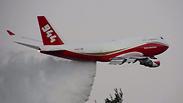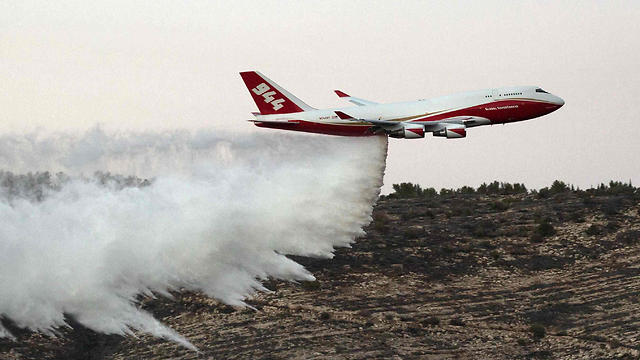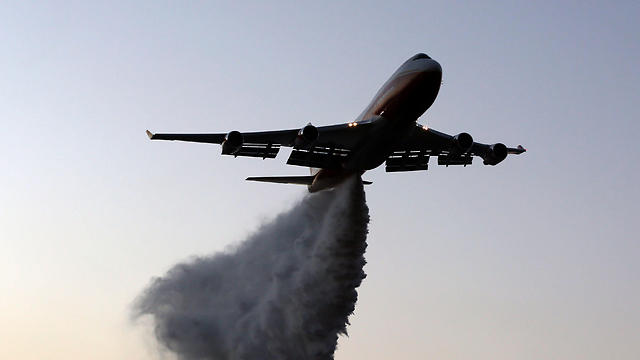
Supertanker: extinguishing flames, fuelling dispute
Fire service accuses police of putting the US Supertanker to frivolous use at a high financial cost before giving the green light to execute fire-extinguishing missions; Police: ‘It was a preventative measure to provide an immediate response. Fires were spreading quickly.’
Since the Boeing-747 Supertanker, manufactured by Global SuperTankern arrived in Israel on Friday, it conduct two extinguishing missions. However, both missions were preceded by the a protracted flight in which the plane circled above the sea awaiting the green light to execute its assigned task.
“We have no idea why you operated it beyond conducting a test run or for a visual performance,” one official said from the fire service.
On Sunday, the Supertanker departed for Haifa, the city hardest hit by the fires, but was forced to wait for two-and-a-half hours above the sea in Atlit, a coastal town located south of Haifa until it finally received permission to proceed to Mount Carmel to release flame retardant on the raging fires.
Upon completion of the mission, which took just seven minutes, the Supertanker returned and landed in Ben Gurion Airport after three hours in the air.
The plane was also used the day before when flew for two hours, once again circling idly above the sea before finally receiving the order to fly to Nataf where it also unleashed flame retardant before a number of reporters and photographers waiting in the area in anticipation of the spectacle.
Given that there were no significant fires at the time of its departure for a mission, question have been asked about the necessity of it conducting circles above the sea all at the cost of tens of thousands of shekels per hour.
Speaking to Ynet, a Jumbo 747 pilot of an Israeli company estimates that the cost of operating the Supertanker stands at around $10,000 per hour, including fuel costs and maintenance. For Israel this equates to 40,000 shekels for the five hours it was put to use. Overall, including the costs of flying the Supertanker to Israel, the country will have to foot the bill of around $1.5 million.
The police, which ultimately decided when and how the plane would be deployed, released a statement defending their decision: “Most of the fires in the last few days developed in the afternoon which were intensified by easterly winds,” the statement began.
“As dusk dawned it became difficult to put the fires out because regular firefighting planes have no capability to operate after dusk. The Supertanker was put on alert in the air as a preventative measure in order to provide an immediate response to any area where a serious fire broke out which could spread. It should be highlighted that the speed at which the fires spread under the weather conditions over the last few days was extremely fast, hence the need for an immediate response.”
The foreign ministry has thus far refused to divulge details of the operational agreements signed with the company based in Colorado Springs. However, an official did state that the contract was signed to cover a period of time and had nothing to do with the number of times the plane is sent into the air. The state will not be publishing the precise figures.













